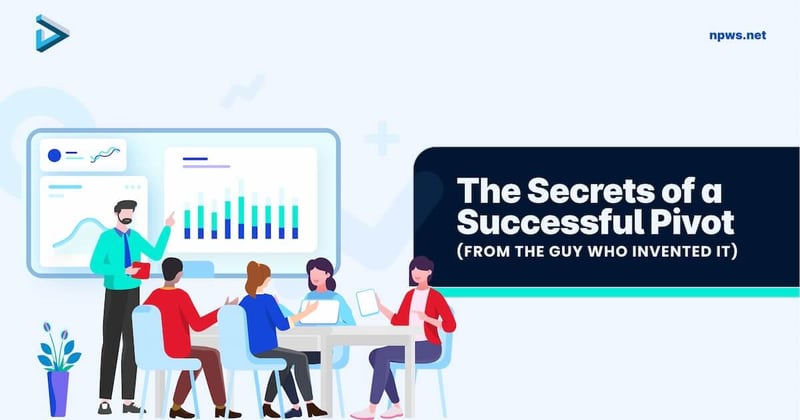The Secrets of a Successful Pivot (From the Guy Who Invented It)

Boardrooms across the country are buzzing. The media is obsessed. Merriam-Webster might as well make it the business word of the year. As the global markets face a pandemic of uncertainty, businesses across all industries are embracing a concept developed by tech startups: the pivot.
Can you blame them? While many industries have been lulled into complacency by long periods of stability, change is inherent for tech startups. Their ideas can be a precious resource in the ever-changing world of 2020. But only if they are understood correctly.
Has the “pivot” been diluted in the process of cross-industry adoption? What’s the original meaning of the word? What can you learn from the man who created the concept? Let’s find out.
Pivot, Don’t Jump
Xerox, a company synonymous with the copy machine, started as the Haloid Photographic Company—a photography equipment manufacturer. Hewlett-Packard’s first product was an audio oscillator. And Nintendo, the iconic video gaming company, tried its luck in the taxi business and the ramen noodles industry before settling on video games. Changing course is hardly a new idea in business. But do these examples qualify as pivots?
“A pivot is a change in strategy without a change in vision,” explains Eric Ries, tech entrepreneur, advisor, and best-selling author who pioneered the term in a 2009 blog post. He likens it to using a GPS: “The vision is the destination you have in mind. If you run into an obstacle, you don’t just run your car into the obstacle over and over again in the hope that it will be fine. You, with the help of your GPS, find a way around. Successful startups are great at this.”
YouTube is a prime example. The world’s largest video sharing platform was supposed to be a video dating site. Difficulty in finding enough dating videos, however, led the founders to accept uploads of any type of videos. Their vision was to leverage the power of online video. They just didn’t know exactly how to do it—in the beginning, businesses rarely do.
While Nintendo made a giant leap from taxi services to ramen noodles before eventually settling on games, YouTube—as well as Facebook, Instagram, PayPal, and numerous tech giants—followed a specific iterative process to adjust its strategy, but never its vision. This process was described in great detail in Ries’ seminal 2012 bestseller Lean Startup.
The Birth of Lean Startup
Deciding when to stay the course and when to change direction is the hardest part of entrepreneurship.
Companies that refuse to acknowledge and embrace feedback from the market inevitably fail. Slowly, at first: they squander resources and team engagement with diminishing returns—before they go out of business, seemingly all of a sudden.
Yet change, too, comes with great risk. The upfront cost of launching a new company, line of products, or business model can put any company in danger. Ries experienced this himself, as a co-founder and CTO of a startup called IMVU.
In 2004, he and his team spent six months working overtime to integrate twelve existing messaging platforms into their product, a platform that combines 3D gaming with instant messaging. They were confident thousands of users would download the platform on the day of the launch. Spoiler alert: they didn’t.
Subsequent user research made the problem obvious: IMVU’s base assumptions of what customers wanted were wrong. No one wanted to use the existing messaging platforms to invite their friends into a platform they didn’t know yet. Users were, however, willing to install a new messaging service to talk to strangers using a 3D avatar.
The team was relieved. They were able to identify and correct the problem before the company ran out of money. Many startups are not so lucky. Eric, nevertheless, couldn’t help but wonder: did they really have to waste six months before learning what their customers wanted?
Of course not. All they needed was a prototype or, as Ries dubbed it: a minimum viable product. “Remove any feature, process, or effort,” he explains, “that does not contribute directly to the learning you seek.”
In this case, they could have simply integrated one of the twelve platforms, invited a handful of users for testing, and then, based on the findings, decided whether to persevere or pivot. Instead of jumping into unknown waters with their eyes closed, they could’ve dipped their toes first.
How to Pivot With the Lean Startup Method
Lean methodology is an iterative process based on a build-measure-learn feedback loop. Does your business need a new strategy? Once you’ve come up with an idea of how you can pivot, you’ll need to validate it. Here are the steps you can take to validate your idea without putting the company at risk:
- Develop the idea: Create a blueprint of the product, strategy, or a new initiative you wish to create. Explain the problem it solves, and how it does this.
- Identify critical assumptions: What makes you think your idea will work? Think of experiments you can run to validate these assumptions before you spend precious time and money to bring your idea to life. Let your inner Eric Ries guide you: “We must learn what customers really want, not what they say they want or what we think they should want.” Behavior wins out against opinion.
- Build a minimum viable product: It can be a smoke-screen MVP—as simple as a pre-order campaign with a video and a landing page for a product that doesn’t exist yet. The Exploding Kittens Kickstarter campaign is a great example. The creators came up with their idea, explained it in a video, and linked to their Kickstarter campaign to see whether people would buy it (they did). Or it can be a concierge MVP—a manual process in the place of an automated one. Fake it ‘till you (possibly, eventually) make it, just like Zappos did.
- Launch your minimum viable product: Put your MVP in front of a small section of your target audience. This experiment will let you observe customer behavior in real life: are they clicking on your ads, sending inquires, or even pulling out their credit cards? No focus group could ever beat that.
- Pivot or persevere: Look at the results. If you’re getting plenty of pre-orders, it makes sense to invest more in your idea. If you’re only getting clicks and video views, it probably needs more tweaking. And if you’re not getting any traction at all, well, you saved yourself precious time and money. Use what you’ve learned to improve your idea.
Successful Pivot: Where to Look for Ideas
Not sure where to begin with your pivot? Eric Ries originally described the three most frequent types of the pivot. Over the years, as he observed more companies, he has expanded the list to include ten typical pivot paths:
- Zoom-in pivot: Double down on what works best. If one of your products, services, or features performs far better than the rest of your offering, you should consider building your business around it. The most famous example of a zoom-in pivot is Instagram.
- Zoom-out pivot: Expand your offering. Turn your existing product into an ecosystem of closely related products, features, or services.
- Customer segment pivot: Are you targeting the right audience? If your products become more popular with a different user segment than planned, you should review your positioning, value proposition, pricing, and channels.
- Customer need pivot: Solve a bigger, more acute problem for your customers. “The ability to learn faster from customers,” Ries advises, “is the essential competitive advantage that startups must possess.”
- Platform pivot: Can you turn your application into a platform or vice versa?
- Business architecture pivot: There are two types of businesses: low margin-high volume and high volume-low margin. You can’t be both at once, but you can pivot from one to the other.
- Value capture pivot: Look for opportunities in alternative revenue models. Free-to-play video games, for example, make more money through microtransactions and advertising than they would if they were selling the game.
- The engine of growth pivot: For most businesses, the primary engine of growth is referrals, paid acquisition, or customer retention. Experiment with all three and find out what works best.
- Channel pivot: Find a more efficient way to distribute your products. Think dealership versus direct sales, for example.
- Technology pivot: Is there a new technology that could help you provide the same solution with superior pricing or performance? This pivot is most common among established businesses.
Which one of these agile pivot paths should your business consider in 2020? The answer is all of them. If there’s one thing we’ve learned after years of helping clients pivot their businesses, it’s that your first idea isn’t likely to be your best idea.
Building a strategic framework to facilitate a successful pivot can take months, even years. But it doesn’t have to: you can simply use ours. The free Pivot Strategy Builder will help you:
- Run a holistic audit of your current business strategy
- Develop potential pivot paths for your business
- Define a list of assumptions to test before you make the final decision: persevere or pivot
“Ask most entrepreneurs who have decided to pivot,” says Ries, “and they will tell you that they wish they had made the decision sooner.”




